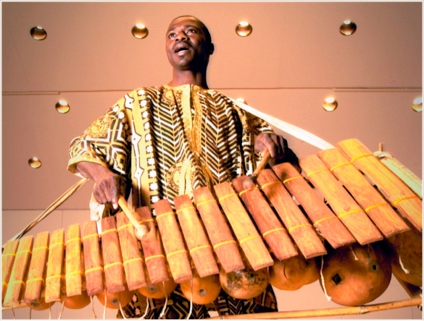Neba Solo

Since 1996 Neba Solo has been dazzling audiences in Mali and abroad with his innovative and virtuosic bala style and thought-provoking compositions. He has become something like the Charlie Parker of the Senufo bala. Just as everyone imitated Bird after his emergence on the bebop scene of the 1940s, so every young bala player longs to play like Neba Solo. There are many imitators but only one Neba Solo.
Balafon is actually the French word for instrument that is known as bala in Bambara and cekiw in Senufo. It is a wooden xylophone with calabash resonators, and comes in various sizes. Wooden xylophones, with various names, tunings, and number of keys are found throughout the African continent, and each cultural tradition has personalized the instrument in its own way.
Neba Solo (b. 1969), whose given name is Souleymane Traoré was raised in the village of Neba which is twenty-five miles northeast of Sikasso, Mali's second largest city in the Southeastern corner of the country. His father Zano Traoré was a master bala player who very early on recognized his son's extraordinary talent. As child Neba Solo learned all instruments in the traditional Senufo ensemble including the bara drums (small and large), the tchatchara, the karinyan, and the ceikiw (bala). As a teenager he and his older brother Ousmane led a group that played for all sorts of celebrations, festivals, dances, naming ceremonies, funerals, weddings, and other social events at villages throughout the Kenedougou region (southeastern Mali). Souleymane's reputation quickly spread by word of mouth and soon people were asking each other whether they had heard the Solo (short for Souleymane) from Neba. Soon everyone was calling him Neba Solo.
When he was eighteen years old Solo heard Alpha Blondy's reggae recording of Jersualem. He was particularly enchanted by the bass line and decided to try building a bala with added bass notes. His father and other Senufo were at first skeptical of the changes he was proposed to make in the instrument. Before he could continue developing his ideas he had to receive his father's permission. They came to an agreement: his father gave him a certain period of time in which to make a recording based on his new ideas. If his father liked the result, he would grant him his permission to continue his musical direction. Solo went into the countryside to gather wood to begin building his new bala. He added three bass notes to the traditional 17 keys and also experimented with various tunings. First and foremost, he wanted to expand the role of the bass line in his music. He ultimately took a traditional Senufo tune that everyone knew and created his own version of it with expanded bass line and new tuning. He played it for Senufo audiences and recorded it for his father. Everyone agreed that the new version of the tune was an improvement and his father, at the end of 1987, granted him permission to pursue his new musical direction.
Throughout the next several years Neba Solo developed a new sound for the bala ensemble. Instead of three bala-one for bass, one for treble, and one for accompaniment-Solo used two bala. The accompaniment parts were distributed between the treble and bass instruments. His brother Siaka, who plays the treble bala, plays and improvises tremble melodies with his right hand while playing accompaniment parts with the left hand. Solo plays and improvises bass lines with his left hand and plays accompaniment parts with his right hand. Neba Solo also began distinguishing himself as a composer, by writing many, many songs on topics of social interest in Mali-vaccination, female excision, corruption, environmental issues, and the like. He has completed his third album, Neba Kady, which has been a smashing success in Mali. He is now looking for a distributor in the West.
Enjoy his music!
Ingrid Monson
Quincy Jones Professor of African American Music
Harvard University
Neba Solo

